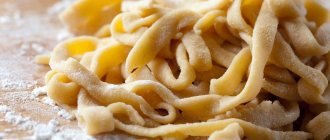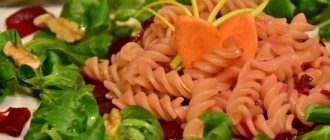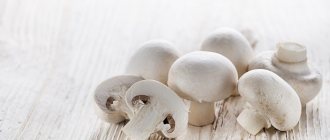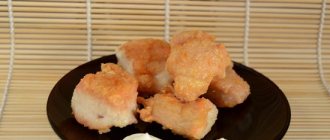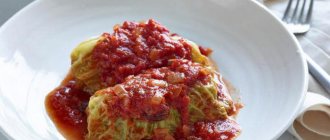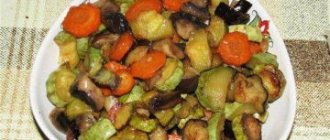How many calories are in an egg
Eggs are considered the lowest calorie protein product that saturates a person for a long time with minimal calorie intake.
Models and famous personalities who watch their figure and strive for constant weight loss prefer to follow the egg diet. Everything is connected with the composition of the product - it contains a large amount of calcium, which is why the diet is not harmful to health. On the contrary, it acts as an effective building material for muscles and has a positive effect on the condition of the hair, nails and skin of those losing weight. But more attention is paid to calorie content. Therefore, it will be interesting to know how many calories are in an egg - chicken, quail, fried and other methods. Despite their effectiveness in weight loss due to their low calorie content, doctors advise against overeating eggs. This is due to the presence of yolk in the composition. It leads to an increase in cholesterol levels in human blood, and the protein has a detrimental effect on the kidneys. In general, eggs negatively affect the liver and contribute to intestinal dysfunction - Lyuli begin to suffer from constipation. But the warnings presented by doctors remain unheeded by people striving for a slim figure. In addition, new research is gradually refuting the harm of the product in the form of the development of cholesterol plaques and other damage to internal organs.
How many calories are in pasta
Pasta (or macaroni) is a specially shaped and dried product made from wheat flour.
Protein fortifiers and flavoring additives are added to the dough, and eggs are added to increase the nutritional value. The benefits of pasta , and these are pasta, horns, feathers, vermicelli, noodles, are as follows:
- The presence of complex carbohydrates , which take a long time to digest and create a feeling of fullness. This property is used in the nutrition of athletes before long, exhausting training and competitions.
- The presence of vitamins B and PP in pasta made from durum wheat and 2nd grade flour.
- The protein content is higher than in bread, especially when enriched with eggs.
- Fiber contained in pasta made from durum wheat accelerates intestinal motility and is a natural adsorbent.
- Allows you to diversify side dishes in your diet.
The calorie content of 100 g of pasta is more than 300 kcal if it is made from premium flour or contains additives.
The “negative” qualities of pasta are:
- high calorie content;
- a large load on the pancreas and an increase in blood sugar when eating boiled pasta;
- significant starch ;
- combined with fats, sauces, spices.
This is a limitation for the inclusion of pasta in the diet of patients with obesity, diabetes mellitus, atherosclerosis, gastrointestinal diseases, incl. with a tendency to constipation.
When calculating calorie content, it is important to take into account not only their variety, but also the method of preparation. Thus, the energy value of boiled pasta is only 98 kcal, and fried pasta is 176 kcal . To find out how many calories are in pasta , enter its weight in grams in the Pasta section in the calculator form below. To calculate the number of kilocalories in naval pasta (on average about 180 kcal), you need to sum up the calorie content of all the ingredients included in the recipe of the dish.
Useful article:
About the composition of eggs
Next, the benefits of eggs will be presented in detail, as well as their calorie content depending on the type. This will help you accurately calculate your recommended caloric intake for the day when including eggs as a main dish or snack, but first you need to understand the composition of the product.
Protein contains the following substances:
- One egg contains up to 87% water,
- protein – 11%,
- 1% carbohydrates,
- 1% minerals.
The composition of the yolk is as follows:
- water – 50%,
- fats – 31%,
- proteins – 17%,
- minerals – 2%.
We recommend reading the article about the egg diet.
It becomes clear why the egg is low in calories - it's all about the high water content. Among other things, a chicken egg contains calcium, phosphorus, potassium, zinc and other useful trace elements. Additionally, it contains vitamins B, A, D, E, PP and others.
Benefits of eggs
The benefits of natural chicken product include the following factors:
- easy digestion of protein - according to numerous studies, it has been found that egg white is much safer than meat white,
- protein is the building material of muscles, so people who regularly eat eggs and play sports can boast of strong muscles,
- the product contains protein - it provides satiety while maintaining weight,
- the yolk contains lecithin - it must be consumed in large quantities by women during pregnancy, since this product promotes the development of the fetal brain,
- animal fats contained in the yolk help improve male sexual function,
- protein helps strengthen hair and prevents the formation of dandruff,
- fatty acids contained in the yolk tone the muscles of children,
- chicken eggs prevent the development of cardiovascular diseases,
- contains provitamin A - it has a detrimental effect on the cells of a developing infection or virus,
- Vitamin D has a positive effect on calcium absorption,
- Choline contained in the composition promotes lipid metabolism and has a positive effect on liver function,
- The lutein contained in the composition is beneficial for vision - it prevents the development of cataracts,
- Selenium helps normalize the functioning of the thyroid gland and strengthens the immune system.
Despite the small number of kilocalories, the product should not be abused. Consumption should be limited if you have diseases of the kidneys, liver, gall bladder, or high cholesterol - here you are allowed to eat no more than 2-3 pieces per week. Before going on a mono-diet with only eggs, it is recommended to consult your doctor.
Diet features
A mono-diet on eggs is effective because it helps to reduce up to 7 kg per week. Everything is explained by its low calorie content, but due to its special composition, certain recommendations for weight loss should be followed.
The basic rules include the following:
- You can reduce the calorie content of foods consumed per day by 300 kcal if you replace breakfast with two boiled eggs,
- for large consumption of eggs, it is recommended to abandon the yolk - the whites will not cause much harm to the body,
- The product is recommended to be consumed boiled for snacking,
- When eating large amounts of protein, you should drink more fluid.
- Check the freshness of the product before use.
We recommend that you read – egg diet for 4 weeks.
Eating protein can negatively affect kidney function. Therefore, during a diet when chicken eggs are consumed to a greater extent, it is recommended to drink more drinks with a weak diuretic effect - green tea, rosehip decoction and just water.
Energy value of an egg
The calorie content of 1 egg depends on the method of preparation of the product, as well as its “origin”. It is known that chicken differs from ostrich or, for example, quail, not only in appearance and size, but in nutritional value - calorie content and composition. Next, data on the calorie content of all possible types of eggs will be presented in detail.
| View | Energy value in kilocalories, kcal |
| Raw | 158 |
| One medium raw egg | 70 |
| In one boiled | 50-70 |
| In a soft-boiled egg | 70 |
| Hard-boiled egg | 50 |
| In one fried in vegetable oil | 125 |
| In quail | 16-17 |
| In raw ostrich | 118 |
A raw egg
The raw product is often consumed by citizens who lead a healthy lifestyle or prefer a raw food diet. There are about 157 kilocalories per 100 grams of raw chicken product.
Since there is not 100 g in one piece, the energy value is calculated taking into account weight:
- small sizes - about 70 kilocalories,
- medium – 80 kilocalories,
- A large chicken egg contains up to 90 kilocalories.
What determines the calorie content of pasta?
Many of you know that not all pasta has the same calorie content. First of all, this indicator depends on the following criteria:
- the method of production of the product and the presence of various additives in its composition;
- the variety of cereal crops that are used to produce this semi-finished product (there are soft and hard varieties).
In addition, one of the clues about the energy value of pasta can be its price . Pasta made from durum wheat , as a rule, has a higher price than products from soft varieties. But the carbohydrate content in expensive products is lower, which determines the low nutritional value of boiled pasta.
Another way to increase the energy value of a dish is to eat pasta. Seasonings, sauces, mayonnaise, ketchups, oils and other tasty “neighbors” of flour dishes on the dinner plate are a reason to completely recalculate the calorie content of boiled pasta, adding calories to them from related products.
For example, one of the most popular seasonings for pasta in the world is cheese , which itself contains a large amount of fat. Such a product can add up to 500 calories to a 100-gram serving of pasta!
How many calories are in fried pasta?
Each of us has tried pasta at least once in our lives, and probably more than once. They are distinguished by very fast cooking, which does not require careful monitoring. But not everyone realizes that pasta is a high-calorie product. So how many calories are in boiled pasta? 100 grams of such pasta contains 366 kcalories. But what is 100 grams, will you be full with that amount? Hardly. We usually put about 300 grams on our plate, which is equal to 1098 calories. But, you see, we are all different, so the serving size will vary significantly. This means that the calorie content of boiled pasta will also depend on the quantity.
But there are very few people who eat empty pasta; we usually have the habit of adding butter to it, and it, like pasta, has a high calorie content. As a result, 100 grams of our pasta and butter dish will contain about 500 calories. And if you eat a full portion of 300 grams, then it’s all 1500. Where does this calorie content of boiled pasta come from? The thing is that they are made from flour, eggs and butter, which contain a large amount of calories, and when mixed, it turns out as if we had eaten a bun.
However, it is pasta that gives the greatest weight loss results. The pasta diet is recognized as one of the best. But why does this happen? Let's try to figure it out.
Many people know that pasta products are a source of carbohydrates. But these carbohydrates are not as fast as in other products. This helps the pasta take longer to digest. And this happens because a substance such as glycogen enters our blood very slowly. That is why, when eating pasta, we always feel full and do not feel hungry for a very long time. This plus contributes to the fact that we are less likely to go to the refrigerator for the next portion of food.
But this is not the only positive point. The second advantage is that eating pasta promotes the production of the “happiness hormone” called serotonin. This is what helps us overcome depression.
Another plus is that pasta contains fat in very small quantities. And also the menu, which consists of all kinds of cones, spaghetti, shells and noodles, has a huge number of dishes. So the diet will not be monotonous and boring.
But it should be remembered that pasta is different from pasta and you should only eat pasta whose components are durum wheat. Yes, and you need to cook them only in accordance with the instructions that can be read on the package. On average, cooking takes from 10 to 12 minutes.
During the pasta diet, you should never eat sugar, and it is advisable to replace the salt with rock or sea salt. At the same time, you can drink absolutely everything, but sips should be small.
Calorie content of boiled pasta with additives: list per 100 g
- Pasta with minced meat calorie content – 125 kcal
- Pasta with breast calorie content – 255 kcal
- Calorie content of pasta with beef – 155 kcal
- Navy pasta calorie content – 236 kcal
- Macaroni and cheese calorie content – 164 kcal
- Calorie content of pasta with onions – 197 kcal
- Makfa pasta calorie content – 334 kcal
- Pasta Barilla calorie content – 359 kcal
- Calorie content of boiled pasta with butter – 180 kcal
- Pasta with egg calorie content – 143 kcal
- Pasta with sauce calorie content – 148 kcal
- Calorie content of pasta with sausages – 203 kcal
- Pasta with vegetables calorie content – 85 kcal
- Pasta with mushrooms calorie content – 174 kcal
Fried pasta with egg
Ingredients
Boiled pasta - 300 g
Chicken eggs - 4 pcs.
Butter - 30 g
Refined sunflower oil – 20 ml
Svan salt - to taste
- 190 kcal
- 10 min.
- 10 min.
Photo of the finished dish
Step-by-step recipe with photos
I’ll be honest: I don’t know if there could be anything simpler than pasta fried with an egg! I was about 9 years old when I first pleased my parents and brother with this dish.
Even a child can cope, and even a bachelor who doesn’t know how to cook at all!
What else is good about this dish: it probably happens to you that you cooked more pasta than was supposed to for the dish, it’s a pity to throw them away (and it’s very wasteful.), and they “hang” in the refrigerator. Well, now is just the time when it’s time to fish them out and cook yourself an easy and, most importantly, quick dinner!
You can eat them just like that (by the way, it turns out very well), or you can serve them with cutlets, meatballs, or salad.
To prepare fried pasta with eggs, prepare the ingredients according to the list.
Place butter in a frying pan and add sunflower oil. Let's warm it up.
And fry them until the desired result. Some people just like oil to coat each pasta, while others (including me) like the pasta to be fried well, until brown. But my family doesn't like it that way, so I fried the pasta just a little.
Beat the eggs into the frying pan with the pasta, add salt to taste and mix immediately. The eggs set very quickly!
Fry, stirring, until the eggs are cooked. This will literally take 1-2 minutes.
You can add your favorite herbs if you wish. I sprinkled it with Svanetian salt.
That's it, fried pasta with eggs is ready! We spent no more than 10 minutes on everything.
Serve the pasta immediately.
If they remain, you can reheat them, but they won’t be as “juicy” anymore.
The benefits of pasta, calorie content of durum wheat pasta
As we already mentioned at the beginning of the article, pasta made from durum wheat is quite low in calories. This fact is due to the fact that they contain more vegetable protein and less fat than pasta made from soft wheat varieties.
In addition, dishes made from durum wheat contain much more amino acids, vitamin B1 , as well as complex carbohydrates and fiber. And yet, eating such pasta will not upset you by unnecessary deviation of the scales. In general, the high cost of such products is fully justified by their benefits for the body!
The main advantage of such pasta is that the complex carbohydrates contained in durum cereal flour have a relatively low glycemic index (GI). In turn, this allows the body to break down carbohydrates much faster, converting calories into energy rather than storing them as fat for a rainy day.
Fried pasta with egg calories
We found out whether Doshirak can be called noodles, what are the benefits of al dente and who needs pasta with eggs
There is even a pasta diet. The main thing is to use it correctly
Photo: Roman Danilkin / 63.RU
Milk soup with noodles, navy pasta, lasagna, pasta carbonara and, of course, the favorite dish of all children - spaghetti with sausages. It seems that you can live your whole life on pasta alone and not think at all about what you will eat tomorrow. But is it worth sticking to such a diet, how to choose the right pasta, and what combination of foods is potentially dangerous? Nutritionist Nina Toritsyna and brand chef Ivan Anufriev helped us understand these and other questions in the “Interesting About Food” section.
Choosing the right pasta
PLOT
It is worth considering several nuances. First, pay attention to the wheat variety. Manufacturers usually have no reason to hide this information, and it is on the packaging. Ideally, the origin of the wheat and the full composition of the product should also be stated.
— The ideal composition of pasta: coarse durum wheat flour, fresh egg (or at least egg powder) and olive oil. All. It is advisable that there is nothing else in the composition. No emulsifiers like “eshek”, advises Ivan Anufriev.
The composition of pasta should be extremely short
Photo: Olga Burlakova / NGS.RU
It is very easy to recognize a quality product when cooking: if the pasta remains firm, this is an excellent option.
— Wrong pasta means extra carbohydrates. This is a direct path to obesity. There is saturation, but what is it? In addition, you should not get carried away with such products. You fill your stomach with pasta, and then what? Where will you eat everything else? — asks Nina Toritsyna. — There is an opinion that you should eat greens a day. And if you’ve already filled your belly with pasta, what then? You won't want to live.
Good pasta - more than 70 rubles
In general, good pasta should not cost less. So if you suddenly find a standard pack of spinach noodles for 40 rubles (and that’s even without a discount!), then you can safely feed it to unwanted guests, but stay away from it yourself. But if you don’t skimp on your stomach and health, then you can easily find healthy tomato, spinach, buckwheat, rice, and only the pasta monster knows which ones.
Pasta for 200 rubles is not an invention of marketers
Photo: Tatyana Tikhonova / 74.RU
To be sure of the composition of the product, experts again recommend preparing everything at home. Here you can add spinach, seaweed, and carrots - whatever you want. The main thing is that it will definitely be natural.
Aldente is healthier than fully cooked pasta
Everything you have heard about the benefits of aldente is true. They are actually healthier than regular pasta, since at this level of readiness, the product retains useful substances - vegetable protein and carbohydrates. But you need to understand that it is better if it is homemade handmade pasta or good quality Italian pasta. If you don’t have time to cook, choose pasta made from durum granadura flour. Their distinctive feature is very coarse grinding, the flour is yellow and coarse, approximately like semolina. Pasta made from really good durum wheat flour is very easy to digest. Even though it is a flour product made from dough, it is impossible to gain weight on it.
Don't confuse al dente with raw pasta
Photo: Roman Danilkin / 63.RU
How long to cook al dente so as not to miss depends on the type of pasta, its thickness and shape, and on whether the pasta is fresh or industrially dried. Plus, there are usually recommendations about cooking time on all packages. But if not, then here’s some basic advice: pasta has a marking, they are divided by number, most often they use number six. These need to be cooked for about nine minutes. Take out one pasta one minute before the manufacturer's recommended number, tear it or cut it. If there is a white dot in the middle, the dough will remain a little hard inside, this is al dente.
Overcooked pasta? Well, don't throw them away. You can also eat this, but you need to understand that there is little benefit in them, pasta has released gluten, and this is starch (found in any cereals) that has turned into a paste. You cook more - more paste and, accordingly, less benefits.
Don't cook pasta with butter
There is an ancient myth that supposedly to prevent pasta from sticking, you need to add sunflower oil to the water. Don't listen to anyone and don't translate products.
- This is a banal self-suggestion; from the point of view of the physical process, it gives absolutely nothing. Oil and water are liquids of different densities. The oil will just simmer at the top. It makes sense to season the finished pasta with oil to prevent it from sticking. But again, good durum wheat pasta should not stick together while it is hot, advises Ivan Anufriev.
If you cook pasta for a couple of hours, you will get an excellent paste.
Photo: Roman Danilkin / 63.RU
At the same time, you can add butter to a ready-made dish or even mix it with olive oil - it will be tasty and healthy.
Sausage will kill all the goodness of your pasta.
Nutritionists say a categorical “no” to pasta and sausages. Although there are some benefits to pasta, this particular combination is unhealthy because it is high in carbohydrates.
- A child needs meat, and the mother replaces it with sausage - this is completely wrong. It's better to eat pasta with vegetables. Because vegetables are vegetable protein and fiber with a small amount of carbohydrates, with a low energy content, and they combine very well, says Nina Toritsyna.
In the usual sense, both vegetables and pasta are all side dishes. But once you combine them, you get a completely independent dish. Pasta goes well with tomatoes, bell peppers, zucchini, eggplant, squash, onions and garlic. There are many pasta recipes with just vegetables - it is a light meal that is quickly digested. Without exception, all vegetables contain immune-strengthening vitamins and essential minerals. And this is a direct greeting to the circulatory system and strong teeth. In addition, vegetables will give the body energy.
Plus, vegetables provide fiber. Because of it, wheat carbohydrates will be absorbed longer. In general, carbohydrate foods go better with vegetables than with meat rich in proteins, and can rightly be considered a dietary food. But we, of course, are not saying that you should completely give up meat - chicken, beef, pork and fish are full of their own pleasant bonuses.
The benefits of pasta end where the harmful effects of other products begin.
Photo: Tatyana Tikhonova / 74.RU
Moreover, pasta made from unrefined wheat varieties is best for children. These are second-class products, they are often gray in color and less processed. If the child is healthy and has no food contraindications, it is better to choose just such products.
But the dish that is not the most favorite among children - milk soup with noodles - is worth taking a closer look at. Although the taste of such soup is familiar to everyone from a young age, not everyone knows about its benefits. Firstly, it simply cannot contain the fat that floats in fried soups. This alone reduces its calorie content to 58 Kcal per 100 grams. Secondly, we remember that milk is recommended even for people engaged in hazardous work, and for children (if they, of course, have no contraindications or personal intolerance) it is even more useful. It contains proteins, fats and carbohydrates necessary for health, which are preserved during cooking. And real, not powdered milk is rich in vitamins. By the way, they are also found in high-quality pasta, along with the iron and manganese necessary for the growing body.
It is important not to overdo it with benefits. Nutritionists still do not recommend eating pasta more than once a week.
You can lose weight on pasta
Of course, foreign experts have already conducted more than one experiment where they have proven that the pasta diet is even healthy and you can lose weight on it. But you will feel a positive effect if you replace other carbohydrates with noodles. Scientists invited for the experiment. They were required to regularly eat pasta instead of other sources of carbohydrates. Those participants who ate pasta more than three times a week were able to lose half a kilogram in . It turned out that pasta itself cannot cause excess weight gain.
You can’t lose a lot on pasta, but half a kilo is also a result
What is the calorie content of noodles per 100 g, what is the calorie content of spaghetti per 100 g?
100 g of spaghetti contains approximately 340 calories and about 1 g of fat. Having a fairly high energy value, the finished dish can provide 9% of the daily calorie intake that an adult needs.
At the same time, depending on the recipe you choose, the calorie content of this pasta may vary. For example, 100 g of bolognese will contain about 200 calories. But spaghetti with seafood will have half the calories.
It is important to remember that thin, compressed spaghetti has a GI ten points lower than similar thick pasta.
Also, it is worth noting another type of pasta, namely noodles . The calorie content of noodles per 100 g is about 320 calories. This pasta product is perhaps the most common in popular world cuisines. Quite often, noodles are prepared from various types of flour at home. At the same time, noodles, which are prepared from pea flour or from durum flour, are considered the lowest in calories. In this case, ready-made boiled noodles not only do not harm the body, but help with dysbacteriosis and restore the intestinal microflora.
But buckwheat noodles are considered the most dietary, with a calorie content of 160 calories per 100-gram serving of the product!
Calorie content of pasta per 100 grams (boiled, hard, with cheese, etc.)
340 kcal, boiled:
175 kcal* * average value per 100 g, depends on the type of flour, type of pasta and cooking methods
Pasta is a popular dish characterized by its nutritional value and high energy value. Different types - spaghetti, noodles, pasta - are used to prepare casseroles, soups and cold appetizers.
How many calories are in 100 grams of pasta?
Pasta is not only tasty, but also a healthy product. Due to the content of vitamin B in products made from durum wheat, a person feels a surge of strength and energy for a long time. Amino acids help normalize sleep and mood, and fiber helps remove all harmful substances from the body and restores intestinal function.
The Italian product differs from the domestic one in composition. In the first case, only flour and water are used, in the second, eggs and butter are added.
Flour for making pasta can be of baking, hard, or glassy varieties. The first option is considered more beneficial for the body. Depending on the type, the calorie content of the product (dry) is 320-360 kcal. About the same numbers apply to buckwheat or white rice.
For your diet, it is better to choose products made from rice or buckwheat flour.
The products of the well-known brand “Makfa” (only durum wheat is used) have 345 kcal, the products do not become overcooked and keep their shape. Barilla has a higher figure - 360 kcal. Spaghetti, bows, lasagna sheets, feathers are distinguished by their excellent taste and high quality. Manufacturers can add tomatoes, spinach, carrots, spices and herbs to create beautiful and more savory pasta.
Calorie content of boiled and fried pasta
The energy value of pasta depends not only on its type, but also on the products that are added during the cooking process. When cooking, the numbers decrease by more than 2 times (about 120 kcal per 100 grams). This is due to the increase in volume of products after boiling.
One standard serving of boiled pasta (150 g) contains 180 kcal.
Additives (butter, sauces, cheese, sour cream) significantly change the value of the finished dish. For boiled products with butter (2 tablespoons), the indicator will be almost 180 kcal per 100 g. Read about the properties and calorie content of butter here.
Nutritionists advise replacing animal oil with vegetable oil. In the homeland of pasta, olive oil is used; when it is added, the energy value is reduced by 20 units (160 kcal). Find out the calorie content of vegetable oils in our article. If you want to fry pasta in oil, you should pay attention to the high calorie content of the finished dish - more than 190 kcal.
Table of calorie content of the product (hard, boiled, with cheese, etc.)
You can find out what energy value different types of pasta have from the calorie content table per 100 g.
Calorie content of pasta dishes
If you boil pasta and add cheese to it, you will get a fairly high-calorie dish (330 kcal) that is not suitable for dietary nutrition. You can reduce the indicator if you use low-fat varieties of dairy product in an amount of no more than 1 tablespoon. You can read about the calorie content of different types of cheese in our publication.
Popular dishes where pasta is the main ingredient:
- baked with egg – 152 kcal;
- with beef stew – 190 kcal;
- with minced meat (navy style) – 230 kcal;
- with pieces of beef – 215 kcal;
- noodle soup – 90 kcal;
- with chicken breast – 290 kcal;
- with Bolognese sauce – 200 kcal.
The most dietary option is durum spaghetti with the addition of vegetables or seafood. The value of such a dish will be only 110-120 kcal.
The quality of the paste, beneficial properties, and energy value depend on the varieties of cereal crops used and manufacturing technologies. During the diet, you should limit consumption to one small serving every 2-3 days.
How to cook low calorie pasta?
Let us immediately note that it is best to eat boiled pasta for breakfast or include it in the lunch diet along with vitamin products. Thus, if you want to maintain your figure and health, forget about pasta for dinner! However, the method of preparing this dish is no less important.
“Aldente” – probably those who have watched a cooking show at least once in their life know this word. It means “undercooked” and is most often applied to pasta and rice dishes. By not cooking the product and leaving it hard, we reduce its GI. At the same time, we can get a dish of boiled pasta with a glycemic index like buckwheat porridge or citrus fruits! Like this!
What is the calorie content of pasta: table by variety
Pasta is a simple and affordable food that is often on the menu of most families. This food is quick to prepare and turns out nutritious and satisfying. Typically, spaghetti and noodles are loved not only by adults, but also by children. They can be made with sausages, minced meat or vegetables. This type of food makes delicious casseroles. But what is the calorie content of pasta, its composition and BJU? Is it possible to eat pasta while losing weight?
Composition and nutritional value of pasta
The exact composition of pasta depends on several factors. Different producers use different varieties of wheat. The most useful are those created from durum varieties. They contain more gluten, but less starch compared to products created on the basis of soft varieties. Therefore, the first type of product can practically not harm the figure.
What else is the benefit of such food? Pasta contains B vitamins, which improves the quality of skin, nails and hair. This food also makes the brain and heart work better. It also contains fiber, which normalizes the functioning of the gastrointestinal tract. But all this is true only in relation to high-quality pasta.
As for the nutritional value of the product, BZHU in this case is an unstable indicator, since it varies depending on the type of product. But the glycemic index is a completely stable category. This is 40 GI, but not for 1 piece, but for the standard 100 grams.
Pasta calorie table
The average ranges from 320 to 350 kcal per 100 grams of dry product. But this figure varies depending on the type of product and its type. The easiest way is to present the calorie content of pasta in a table indicating the BJU for each specific variety:
| Types of pasta | Calories (kcal) | Proteins (g) | Fats (g) | Carbohydrates (g) |
| Whole grain Makfa | 361 | 13,9 | 1,4 | 73,1 |
| Barilla | 353 | 12,0 | 2,0 | 71,7 |
| Noodles Rollton | 448 | 8,8 | 20,7 | 56,7 |
| Milk pasta | 345 | 11,5 | 2,9 | 67,1 |
| Vermicelli Myllyn Paras | 344 | 10,4 | 1,1 | 71,5 |
| Premium pasta | 337 | 10,4 | 1,1 | 69,7 |
| 1st grade | 335 | 10,7 | 1,3 | 68,4 |
| Egg | 345 | 11,3 | 2,1 | 68 |
| Penne All Arabiata | 160 | 4,6 | 3,9 | 26,7 |
| Vermicelli Mivina | 393 | 7,7 | 18,9 | 50 |
| Shebekinsky | 350 | 13 | 1,5 | 72 |
The calorie content of rice and buckwheat noodles deserves special attention, since these products also belong to the category of pasta. How many calories are in buckwheat? This variety “weighs” 348 kcal, and the rice version weighs 344 kcal.
Here are just the main varieties with energy value per 100 grams. However, the calorie content of raw semi-finished products is indicated here. After cooking, these numbers are usually reduced by 2.5-3 times. What explains this? It's simple: during the cooking process, the products swell and become larger. Therefore, the energy value of 100 grams of ready-made pasta and 100 grams of dry pasta are radically different.
Recipe: Pasta fried with egg. Calorie, chemical composition and nutritional value.
Nutritional value and chemical composition of “Fried pasta with egg.”
The table shows the nutritional content (calories, proteins, fats, carbohydrates, vitamins and minerals) per 100 grams of edible portion.
| Nutrient | Quantity | Norm** | % of the norm in 100 g | % of the norm in 100 kcal | 100% normal |
| Calorie content | 241.1 kcal | 1684 kcal | 14.3% | 5.9% | 698 g |
| Squirrels | 7.2 g | 76 g | 9.5% | 3.9% | 1056 g |
| Fats | 12.8 g | 56 g | 22.9% | 9.5% | 438 g |
| Carbohydrates | 24.3 g | 219 g | 11.1% | 4.6% | 901 g |
| Water | 55.5 g | 2273 g | 2.4% | 1% | 4095 g |
| Ash | 0.231 g | ~ | |||
| Vitamins | |||||
| Vitamin A, RE | 60 mcg | 900 mcg | 6.7% | 2.8% | 1500 g |
| Retinol | 0.058 mg | ~ | |||
| beta carotene | 0.014 mg | 5 mg | 0.3% | 0.1% | 35714 g |
| Vitamin B1, thiamine | 0.016 mg | 1.5 mg | 1.1% | 0.5% | 9375 g |
| Vitamin B2, riboflavin | 0.102 mg | 1.8 mg | 5.7% | 2.4% | 1765 g |
| Vitamin B4, choline | 57.94 mg | 500 mg | 11.6% | 4.8% | 863 g |
| Vitamin B5, pantothenic | 0.3 mg | 5 mg | 6% | 2.5% | 1667 g |
| Vitamin B6, pyridoxine | 0.032 mg | 2 mg | 1.6% | 0.7% | 6250 g |
| Vitamin B9, folates | 1.615 mcg | 400 mcg | 0.4% | 0.2% | 24768 g |
| Vitamin B12, cobalamin | 0.12 mcg | 3 mcg | 4% | 1.7% | 2500 g |
| Vitamin D, calciferol | 0.508 mcg | 10 mcg | 5.1% | 2.1% | 1969 |
| Vitamin E, alpha tocopherol, TE | 4.369 mg | 15 mg | 29.1% | 12.1% | 343 g |
| Vitamin H, biotin | 4.662 mcg | 50 mcg | 9.3% | 3.9% | 1073 g |
| Vitamin K, phylloquinone | 0.6 mcg | 120 mcg | 0.5% | 0.2% | 20000 g |
| Vitamin RR, NE | 0.8308 mg | 20 mg | 4.2% | 1.7% | 2407 g |
| Niacin | 0.044 mg | ~ | |||
| Macronutrients | |||||
| Potassium, K | 32.31 mg | 2500 mg | 1.3% | 0.5% | 7738 g |
| Calcium, Ca | 12.69 mg | 1000 mg | 1.3% | 0.5% | 7880 g |
| Magnesium, Mg | 2.77 mg | 400 mg | 0.7% | 0.3% | 14440 g |
| Sodium, Na | 30.92 mg | 1300 mg | 2.4% | 1% | 4204 g |
| Sera, S | 40.62 mg | 1000 mg | 4.1% | 1.7% | 2462 g |
| Phosphorus, P | 44.5 mg | 800 mg | 5.6% | 2.3% | 1798 |
| Chlorine, Cl | 36 mg | 2300 mg | 1.6% | 0.7% | 6389 g |
| Microelements | |||||
| Iron, Fe | 0.577 mg | 18 mg | 3.2% | 1.3% | 3120 g |
| Yod, I | 4.62 mcg | 150 mcg | 3.1% | 1.3% | 3247 g |
| Cobalt, Co | 2.308 mcg | 10 mcg | 23.1% | 9.6% | 433 g |
| Manganese, Mn | 0.0067 mg | 2 mg | 0.3% | 0.1% | 29851 g |
| Copper, Cu | 19.15 mcg | 1000 mcg | 1.9% | 0.8% | 5222 g |
| Molybdenum, Mo | 1.385 mcg | 70 mcg | 2% | 0.8% | 5054 g |
| Selenium, Se | 7.085 mcg | 55 mcg | 12.9% | 5.4% | 776 g |
| Fluorine, F | 12.69 mcg | 4000 mcg | 0.3% | 0.1% | 31521 g |
| Chromium, Cr | 0.92 mcg | 50 mcg | 1.8% | 0.7% | 5435 g |
| Zinc, Zn | 0.2562 mg | 12 mg | 2.1% | 0.9% | 4684 g |
| Digestible carbohydrates | |||||
| Mono- and disaccharides (sugars) | 0.2 g | max 100 g | |||
| Essential amino acids | |||||
| Arginine* | 0.182 g | ~ | |||
| Valin | 0.178 g | ~ | |||
| Histidine* | 0.078 g | ~ | |||
| Isoleucine | 0.138 g | ~ | |||
| Leucine | 0.249 g | ~ | |||
| Lysine | 0.208 g | ~ | |||
| Methionine | 0.097 g | ~ | |||
| Methionine + Cysteine | 0.166 g | ~ | |||
| Threonine | 0.141 g | ~ | |||
| Tryptophan | 0.046 g | ~ | |||
| Phenylalanine | 0.15 g | ~ | |||
| Phenylalanine+Tyrosine | 0.261 g | ~ | |||
| Nonessential amino acids | |||||
| Alanin | 0.164 g | ~ | |||
| Aspartic acid | 0.284 g | ~ | |||
| Glycine | 0.097 g | ~ | |||
| Glutamic acid | 0.408 g | ~ | |||
| Proline | 0.092 g | ~ | |||
| Serin | 0.215 g | ~ | |||
| Tyrosine | 0.111 g | ~ | |||
| Cysteine | 0.067 g | ~ | |||
| Sterols (sterols) | |||||
| Cholesterol | 131.54 mg | max 300 mg | |||
| beta sitosterol | 19.231 mg | ~ | |||
| Saturated fatty acids | |||||
| Saturated fatty acids | 1.8 g | max 18.7 g | |||
| 14:0 Miristinovaya | 0.009 g | ~ | |||
| 15:0 Pentadecane | 0.002 g | ~ | |||
| 16:0 Palmitinaya | 1.069 g | ~ | |||
| 17:0 Margarine | 0.007 g | ~ | |||
| 18:0 Stearic | 0.597 g | ~ | |||
| 20:0 Arakhinovaya | 0.036 g | ~ | |||
| 22:0 Begenovaya | 0.067 g | ~ | |||
| Monounsaturated fatty acids | 3.435 g | min 16.8 g | 20.4% | 8.5% | |
| 16:1 Palmitoleic | 0.09 g | ~ | |||
| 17:1 Heptadecene | 0.002 g | ~ | |||
| 18:1 Oleic (omega-9) | 3.223 g | ~ | |||
| 20:1 Gadoleic (omega-9) | 0.009 g | ~ | |||
| Polyunsaturated fatty acids | 6.541 g | from 11.2 to 20.6 g | 58.4% | 24.2% | |
| 18:2 Linolevaya | 6.004 g | ~ | |||
| 18:3 Linolenic | 0.014 g | ~ | |||
| 20:4 Arachidonic | 0.023 g | ~ | |||
| Omega-6 fatty acids | 6.2 g | from 4.7 to 16.8 g | 100% | 41.5% |
The energy value of fried pasta with egg is 241.1 kcal.
Primary Source: Created in the application by the user. Read more.
** This table shows the average levels of vitamins and minerals for an adult. If you want to know the norms taking into account your gender, age and other factors, then use the “My Healthy Diet” application.
How many calories are in prepared pasta: with butter, cheese, egg, fried
The energy value of the finished product depends on the cooking method. For example, 100 grams of boiled pasta contains 112 kcal. But there is no such fundamental difference between dry and boiled spaghetti, since during the cooking process they do not increase in volume so much. Therefore, with a starting 330 kcal, the boiled dish will contain about 220 units (1 standard serving without oil). The same story with vermicelli. Therefore, if in dry form it contains about 370 calories, then after boiling the figure will be up to 190 kcal.
Photo source: shutterstock.com
When including pasta in your menu, it is important to understand: most of the calories are not found in products cooked in water. The high calorie content of the dish is created by sauces, gravies and other additives with which they are usually served.
Buckwheat noodles, which weigh quite a lot when dry, give only 150 kcal after cooking.
One of the most common additives is oil. By adding butter, the energy value of pasta reaches 160 kcal per 100 g. But pasta with cheese “weighs” quite a lot. For the same amount, calorie content increases to 330 units.
Photo source: shutterstock.com
Many people can’t resist fried navy pasta. But just 1 serving is 330 kcal. Fried dough products without adding other ingredients - 176 units. Baked with egg - 152 calories, lasagna with vegetables - 212, and pasta with seafood (risotto sea) - 104.
You can find out what pasta you are allowed to eat during the diet from the video:
Navy pasta, preparation and nutritional value
The calorie content of navy-style pasta directly depends on the type of minced meat used in preparation.
Minced pork with a high fat content gives the dish more calories.
To significantly reduce the number of calories in this tasty dish, you can use minced meat from lean meats: veal, chicken, lean beef, for example, the calorie content of pasta with chicken will be 300 kcal, and with minced meat it is already 234 kcal per 100 grams.
Oil can also be almost completely excluded from the cooking ingredients.
In this case, the minced meat can be stewed in a frying pan with a minimum amount of regular or filtered water and 1 spoon of oil.
Ingredients:
- Pasta 450 grams;
- ground beef;
- 350 grams, vegetable oil;
- salt pepper.
Cooking method:
Boil them, and the cooking water should be salted.
Immediately drain in a colander and rinse very thoroughly.
Fry the minced meat with onions well in a heated frying pan, adding olive oil, and if not, then vegetable oil.
Calorie content of navy pasta per 100 g: 200.45 kcal.
The nutritional value:


